9 Yoga Poses For When You Need a Fresh Start
This article originally appeared on Yoga Journal
I don't have any regrets when it comes to my yoga path. Even with all of my injuries, disappointments, missed opportunities, and failures, I wouldn't change a single breath or pose.
I don't regret saying yes to teaching jobs that didn't work out. How many times over my fifteen-year career did I pick up a class time that either didn't build or that dwindled after I took it over? My first instinct was often to take it personally or assume I had failed, but in retrospect I see that if those opportunities had worked out, I would be on an entirely different path today. I don't regret doing poses that likely contributed to my repetitive stress injuries. It has been through injury, motherhood, and aging that I've really been able to learn about non-attachment.
I don't even regret blindly following teachers who ended up falling off their pedestals and hurting me in some way. Experiencing disappointment with a teacher or mentor was a huge opportunity for me to learn to do things differently. It helped me see where to draw boundaries and how to manage my energy more appropriately in my own relationships.
Let’s Try That Again
Although I have no regrets about these moments, I do appreciate the idea of being able to reset and to begin again. I don't necessarily want a do-over--not in an erase-the-past, blank-slate kind of way. Rather, I want a do-again-better.
When I start teaching a new class or learning a new pose or studying under a new teacher, I want to go through these experiences differently than I did before--employing the wisdom I gained from my previous experiences, but also aware that this is a fresh start. This is time to reset, rather than redo.
In this sequence, we revisit familiar poses from a fresh, perhaps wiser, lens. I hope it reminds you of the many possibilities available to you and helps you clear any old attachments or hurts.
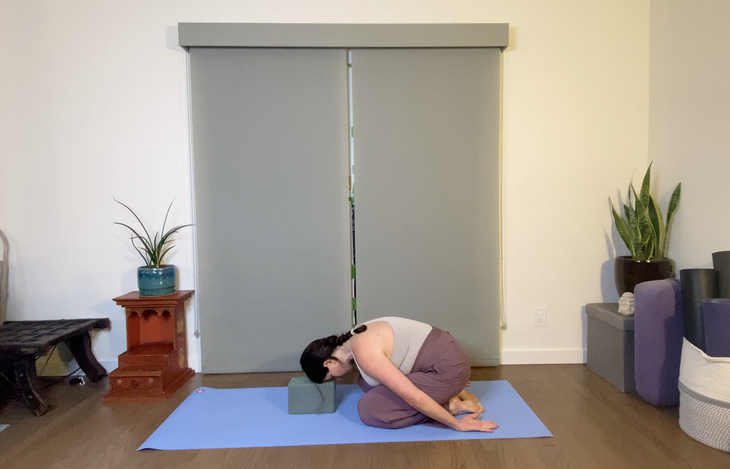
1. Balasana (Child's Pose)
Is there any pose that represents new beginnings more than the fetal position? This pose represents a literal starting over--a return to when we were born. In this variation of the pose, we will leave the arms by our sides, but keep our palms facing upward as a symbol of embracing new possibilities.
How to: Come down onto your knees. Bring your big toes together and separate your knees apart. Shift your bum back to your heels and rest your tummy on or between your thighs. Place your forehead on the floor or a block, then drape your arms back by your sides. Turn your upper arm so that your palms face skyward. This internal rotation of the upper arm can lead to excessive rounding of the upper back, so keep your shoulder heads lifting from the floor. Rest here for ten breaths. Then slowly, as if you were going for a swim through honey, reach one arm then the other in front of of you.
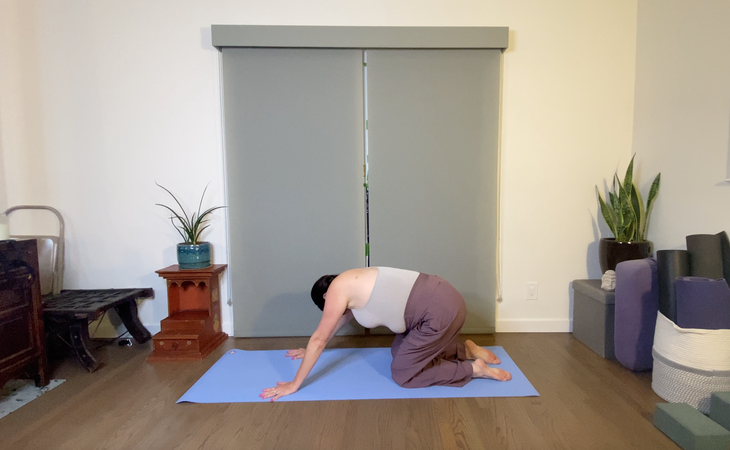
2. Marjaryasana and 3. Bitilasana (Cat and Cow Pose)
The dynamic sequence of Cat/Cow allows us to witness that every breath cycle can be an opportunity to begin again and again. We usually focus on spinal extension (arching) and flexion (rounding) in Cat/Cow. In this variation, we will move our body in circles. This rotational movement helps to create space in the ball-and-socket joints of the hips and shoulders. Circling one way then switching directions symbolizes starting over.
How to: From Child's Pose, inhale and come to Tabletop. On your next inhalation, take your chest forward so that your shoulders are ahead of your wrists and arch your back. Then shift your shoulders and hips to the right and back. Exhale, coming through Child's Pose with your back rounded and then circle your hips and body to the left, coming around the other side transitioning into Cow pose as you inhale and bring your shoulders ahead of your wrists. Continue in this direction for three revolutions, then switch directions.
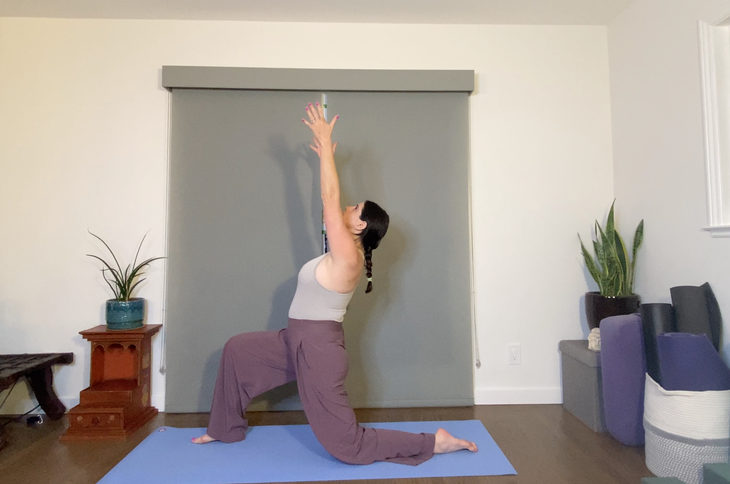
4. Low Lunge Twist
There is something about wringing yourself out, much like you would a sopping washcloth, to help release old energies. But wringing out doesn't mean totally drying out. Some moisture remains but it helps to remove the excess stuff we tend to hang onto.
How to: Starting from Tabletop, step your right foot between your hands. Keep your left hand on the floor under your shoulder or on a block. Inhale and lift your right arm up toward the ceiling. Exhale and twist your torso open toward your front inner knee. If your neck is sensitive, continue to look down or to the side. Otherwise, you may look up at your raised hand. Try not to crank yourself into the twist. Instead, let every breath take you a little further. Inhale, lengthen your spine from crown to tail; exhale, twist yourself a little further. Do this for five breaths. Release your right hand down and come back to hands and knees and set up for side two.
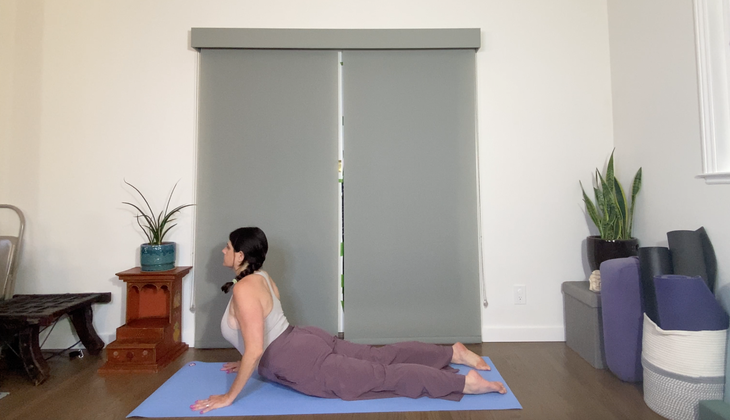
5. Bhujanagasana (Cobra Pose), variation
To begin again, we often need to re-open our heart. Lifting and lowering in this mild backbend, which is sometimes called Seal Pose, is a gentle way to tease the heart back open after a disappointment. In this pose, we are on the floor, so there is an element of grounding, but pressing up adds an energy of re-emerging.
How to: From Tabletop pose, curl your toes under, lift your shins, and reach your hips up and back into Downward Facing Dog. Inhale to come forward into a Plank, then lower yourself to the floor, coming to your knees first if necessary. Place your palms under your shoulder heads and separate your legs and feet hip-width apart. On an inhale, press away from the floor, extending your arms halfway toward straight, and peel your chest and tummy off the floor. Your elbows will remain slightly bent. Slide your shoulders away from your ears. On an exhale, lower back to the floor. Repeat this three times. Think of lengthening your spine each time you lower, so each round informs the next. After your last round, curl your toes under and press back to Downward Facing Dog.
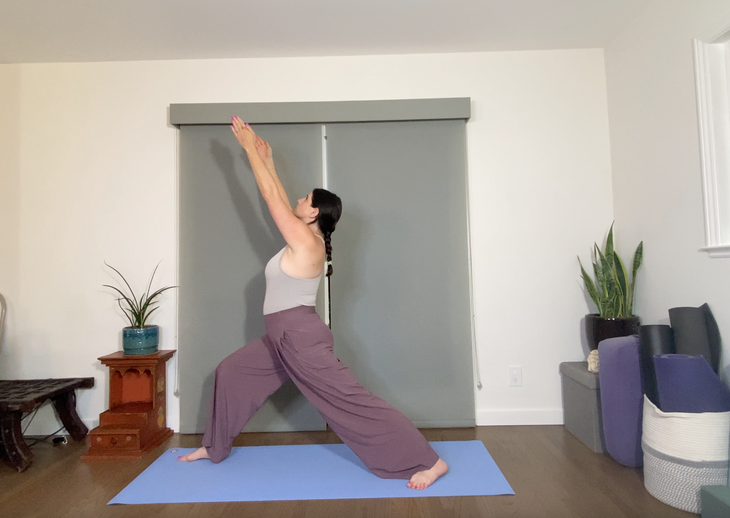
6. Virabhadrasana 1 (Warrior 1 Pose), variation
Warrior 1 gets a rep for being a bit of a push-pull throughout the body. For example, your back leg firms toward straight and pulls back, but then your back hip wraps forward. And we would not be able to make space in our lower back were it not for our back foot firmly planting. This pose represents the resistance we often feel to starting over and beginning again. But it is also an opportunity to make space to grow from our past.
How to: From Downward Facing Dog, inhale and lift your right leg up to the sky. On an exhale, step your right foot between your hands. Turn your left toes out and hop your foot to the left slightly until both feet are a comfortable distance apart. We are going to keep our chest down today. Take your thumb to your right thigh and hip region and gently draw your hip back. Keep your right foot anchored into the mat. Now hover your torso one inch off your right thigh and reach your left arm forward. If your lower back feels spacious and stable, consider reaching your right arm forward, too. As much as your arms reach forward, anchor your feet into the floor and pull your hips back. Hold for five breaths. Exhale and bring both hands to the ground and step back to Downward Facing Dog. Prepare for your left side.
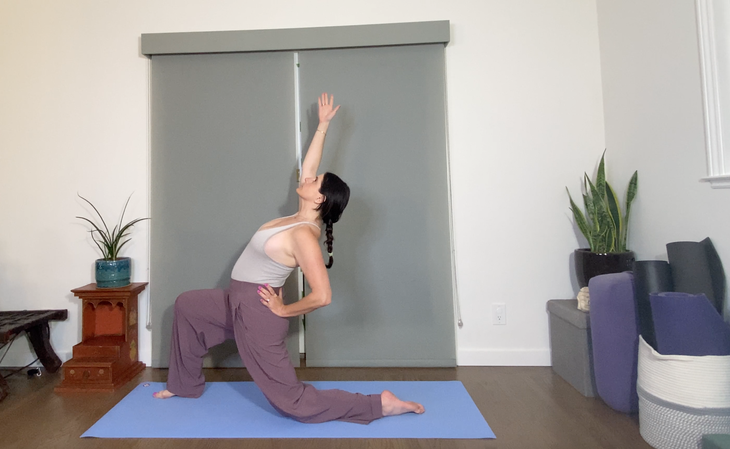
7. Ustrasana (Camel Pose) variation
Let's continue with this theme of observing push-pulls in the body, but this time, the pull will be to arch back while we work on keeping the energy moving forward. This variation is sometimes called Ardha Ustrasana (Half Camel Pose). It is a hybrid of a lunge shape, which shares a lot of the qualities we just explored in Warrior 1 and Camel Pose.
How to: From Downward Facing Dog, inhale your right leg up and back. Exhale, step your right foot forward and lower your back knee to the floor. Lift your torso upright and pause. Place your left palm flat onto your sacrum with your fingers pointing up or down. Inhale and reach your right arm up to the sky. On an exhale, begin to arch back. Your left hand may slide further down your left leg toward your glute, thigh, or shin. As tempting as it is to go all the way back, keep your focus on lifting your chest and drawing your torso toward your front knee. Hold for five breaths. Ground into your back shin, inhale and bring your torso upright. Lower both hands on either side of your front foot. Step back to Downward Dog.
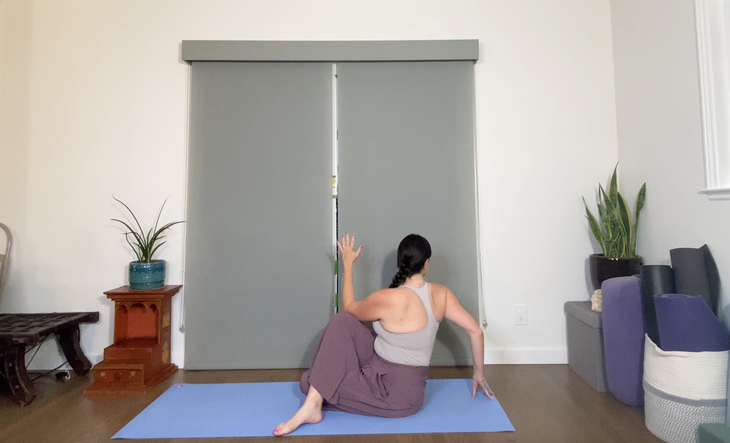
8. Ardha Matsyendrasana (Half Lord of the Fishes Pose)
Twists also represent coming in toward ourselves before reaching out to the world expansively. It's as though we must first do a heart check before we can open ourselves up. Twists are some of the best prep and counter poses to backbending.
How to: Come to a seated position. Stretch both legs straight in front of you. Sit on a blanket or block if that helps you sit upright without rounding. Bend your right knee and cross the foot over your left thigh. Your right knee will continue to point skyward. Now bend your left knee and pull your heel just outside of your right bum. On an inhale, reach your left arm up. On an exhale, twist your torso rightward. Wrap your left arm around the front of your thigh or try to hook your left elbow on the inside of your right knee for more leverage to twist. Choose whichever variation allows you to broaden your chest and breathe fully. Turn your head to look toward your right shoulder. Hold for five breaths. Turn your head to the left first, then release the rest of your body. You will notice the body unfurling organically. Stretch both legs straight and repeat on your left side.
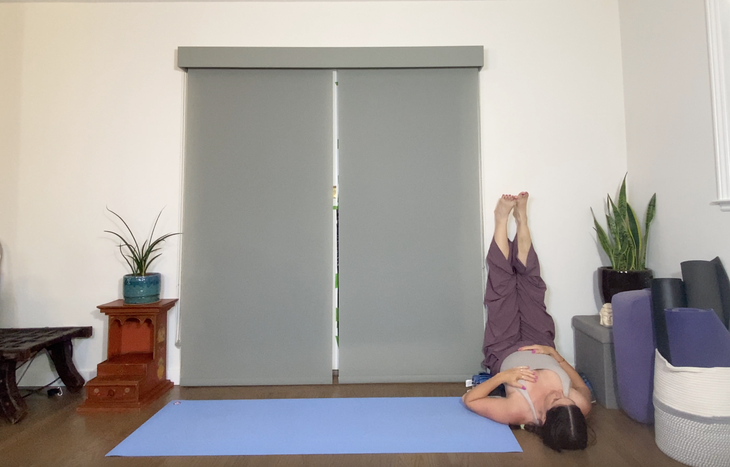
9. Viparita Karani (Legs Up the Wall Pose)
Often what is needed to begin again cleanly is a shift in perspective. Going upside down can offer us that. Viparita Karani also has a restorative element to it as you are held by the wall and floor. This represents the surrender necessary in starting over, too. We have to trust that we are held and supported as we return to a place we once were, but anew. This pose represents trust, rest, and new beginnings.
How to: Come to a wall and sit sideways next to it. Lie down and swing your legs up the wall so your sit bones are touching the wall and your sacrum is flat on the ground. You may want to slide a thin, folded blanket underneath you, resting it comfortably in the archway of your lower spine. Let your arms rest by your sides. Close your eyes or let them rest on a soft gazing point. Remain for five minutes.
Coming out will be just as important as getting in here: Bend your knees and slide your feet down the wall once again. Roll to a side and pause in this curled up position. Take your time, press yourself up to sit slowly, letting your head come up last. This represents that we will enter this new phase leading from our inner self and heart. Find a comfortable seat and pause in the possibility of this moment.
About Our Contributor
Sarah Ezrin is an author, world-renowned yoga educator, popular Instagram influencer, and mama based in the San Francisco Bay Area. Her willingness to be unabashedly honest and vulnerable along with her innate wisdom make her writing, yoga classes, and social media great sources of healing and inner peace for many people. Sarah is changing the world, teaching self-love one person at a time. She is also the author of The Yoga of Parenting. You can follow her on Instagram at @sarahezrinyoga and TikTok at @sarahezrin.
For exclusive access to all of our fitness, gear, adventure, and travel stories, plus discounts on trips, events, and gear, sign up for Outside+ today.

